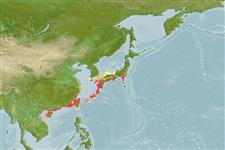>
Eupercaria/misc (Various families in series Eupercaria) >
Sparidae (Porgies)
Etymology: Acanthopagrus: Greek, akantha = thorn + Greek, pagros, a kind of fish (Ref. 45335); chinshira: Named for its local name around Nakagusuku Bay, Okinawa Island; noun in apposition.
Environment: milieu / climate zone / rango de profundidad / distribution range
Ecología
marino pelagic-neritic. Temperate
Northwest Pacific: from Okinawa Island, Japan, northwest coast of Taiwan, and Hong Kong.
Tamaño / Peso / Age
Madurez: Lm ? range ? - ? cm
Max length : 20.4 cm SL macho / no sexado; (Ref. 75207)
Short description
Claves de identificación | Morfología | Morfometría
Espinas dorsales (total) : 11; Radios blandos dorsales (total) : 11; Espinas anales: 3; Radios blandos anales: 8; Vértebra: 24. This species differs from its congeners by having the following set of characters: pelvic and anal fins are pale (yellow when fresh); D XI, 11; 4 1/2 scale rows above lateral line to base of middle dorsal spine; pored lateral-line scales 46-49 (usually 47 or 48); lower edge of infraorbitals straight; 6 rows of cheek scales; without diffuse black blotch at origin of lateral line and black spot on upper base of pectoral fin (Ref. 75207).
Body shape (shape guide): short and / or deep.
Large and fully matured adults are caught around coastal waters of Okinawa Island in midwinter, observed when fishery of this species is carried out by using set nets, gill nets, and bottom long-lines. Juveniles smaller than 10 cm) occur near shore from late spring to mid-summer. Almost nothing is known about the larvae and juveniles in spite of the commercial importance of this species in Okinawa Island, Japan (Ref. 75207).
Life cycle and mating behavior
Madurez | Reproducción | Puesta | Huevos | Fecundidad | Larva
Kume, M. and T. Yoshino, 2008. Acanthopagrus chinshira, a new sparid fish (Perciformes: Sparidae) from the East Asia. Bull. Natl. Mus. Nat. Sci. Ser. A. Suppl. 2:47-57. (Ref. 75207)
IUCN Red List Status (Ref. 130435: Version 2025-1)
Threat to humans
Harmless
Human uses
Pesquerías: comercial
Herramientas
Special reports
Download XML
Fuentes de Internet
Estimates based on models
Preferred temperature (Referencia
123201): 21.4 - 26.6, mean 24.3 °C (based on 168 cells).
Phylogenetic diversity index (Referencia
82804): PD
50 = 0.5000 [Uniqueness, from 0.5 = low to 2.0 = high].
Bayesian length-weight: a=0.01995 (0.00874 - 0.04557), b=2.97 (2.80 - 3.14), in cm total length, based on LWR estimates for this Genus-body shape (Ref.
93245).
Nivel trófico (Referencia
69278): 3.3 ±0.4 se; based on size and trophs of closest relatives
Resiliencia (Referencia
120179): Medio, población duplicada en un tiempo mínimo de 1.4-4.4 años (Preliminary K or Fecundity.).
Fishing Vulnerability (Ref.
59153): Low vulnerability (15 of 100).
🛈
